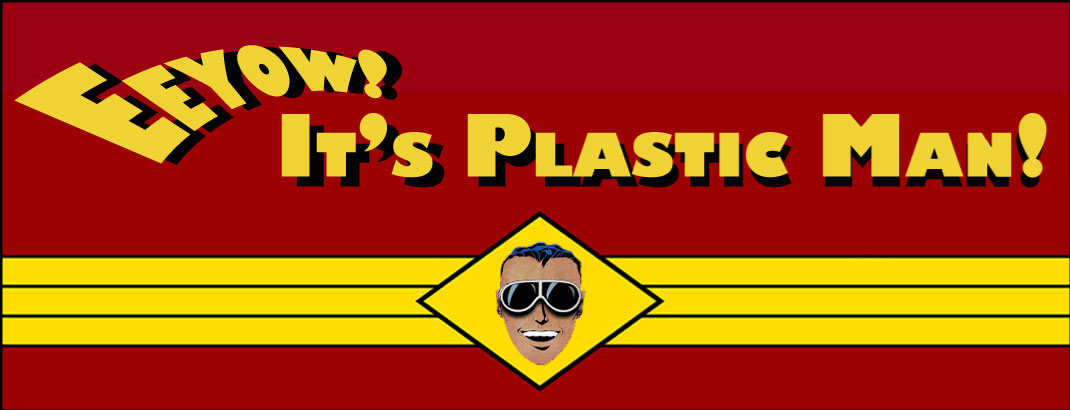Posted: September 29th, 2014 | Author: Max Romero | Filed under: Uncategorized | Tags: Cover to Cover | No Comments »
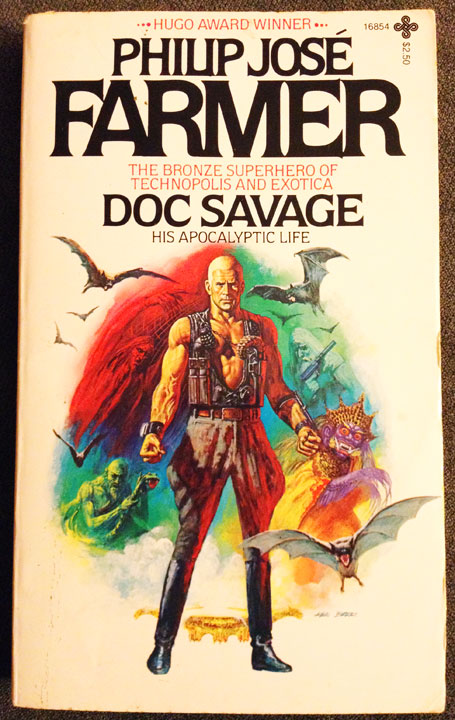
Are you awesome? As awesome as this Doc Savage cover by comic book, sci-fi and fantasy artist Ken Barr? Or as awesome as Scott Slemmons, who sent this book to me just because he is, by definition, awesome?
Well?!?
Doc Savage
Cover illustration: Ken Barr
1981 edition (First Playboy Paperbacks)
Posted: September 26th, 2012 | Author: Max Romero | Filed under: Uncategorized | Tags: Cover to Cover | 3 Comments »
In the interest of full disclosure, I’ll admit that I haven’t read The Voyage of the Space Beagle yet.
I actually haven’t read anything by author A.E. van Vogt yet, even though I’ve got a few of his books sitting patiently in my pile of pulp sci-fi. This has more to do with my bad habit of grabbing more books than I can read at a time (where next thing I know I’m looking at a stack of unread novels and having a panic attack because SO MUCH TO READ) than any foot-dragging because, by most accounts. van Vogt is considered a master of the Golden Age of science fiction.
How influential was he? Maybe one of the most well-known anecdotes has to do with The Voyage of the Space Beagle, which includes the story “Black Destroyer” and has been credited as one of the inspirations for a little movie called Alien. And while the iconic creature designs of H.R. Giger can’t be matched for personifying sheer, ferociously perfect terror, the astronaut-eating monster on this cover is nothing I’d want to mess with either.
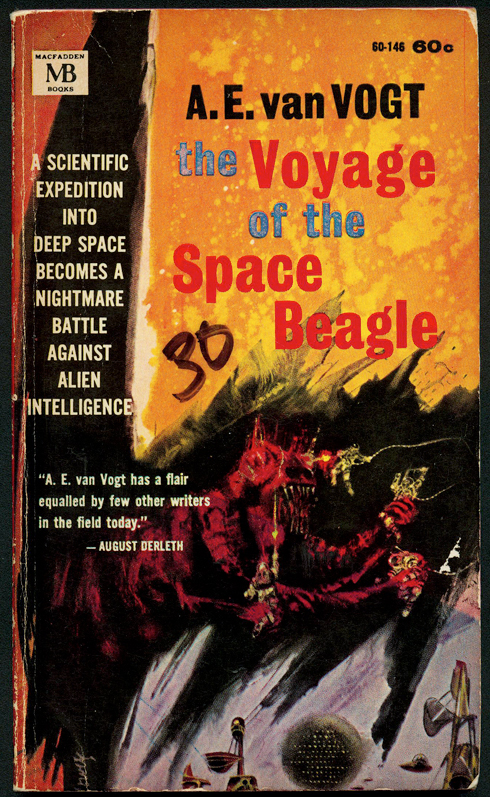
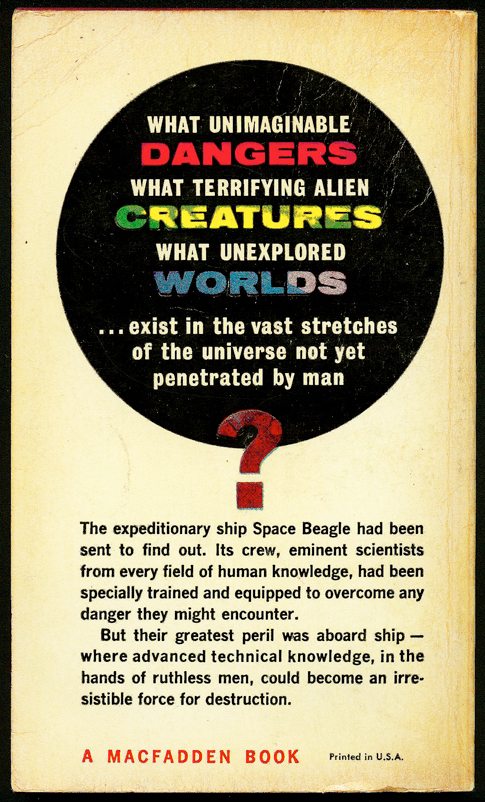
Unfortunately, the cover illustrator isn’t credited anywhere in this 1963 edition, a common crime at the time. But a little digging reveals that the artist was most likely Richard M. Powers, a renowned sci-fi illustrator who did other work for the same publisher, including at least a couple more for van Vogt titles. If you’re ready to spiral down a rabbit hole of fantastic, 60s-era pulp art, do an image search for Powers and prepare to fall in love with your new favorite cover artist.
As a writer, van Vogt had his detractors. Many criticized his willingness to be ambiguous where both plot mechanics and story endings were concerned, but he also apparently inspired well-regarded sci-fi heavyweights like Phillip K. Dick and Harlan Ellison (a personal favorite of mine). A final verdict will have to wait until I’ve actually read the evidence for myself.
But will I ever get around to reading The Beast? Or The War Against the Rull? Masters of Time? Empire of the Atom or Future Glitter?
Back off, man — I told you, I’m gonna get to ’em. Eventually. The Voyage of the Space Beagle, though, will definitely be the first.
Hey, August Derleth liked it!
The Voyage of the Space Beagle
Cover illustration: Richard M. Powers (unconfirmed)
1963 edition (MacFadden Books)
Posted: June 20th, 2012 | Author: Max Romero | Filed under: Uncategorized | Tags: Cover to Cover | 7 Comments »
I’ve been a fan of science fiction for … well, for as long as I can remember. I don’t know if it was the battered copies of Analog and Asimov’s Science Fiction lying stacked in cardboard boxes at my aunt’s bookstore, or the Foundation set my mom got for me at an early age (there’s Asimov again), or the “aliens attack” movies my dad would sit me down in front of the TV to watch most Sunday afternoons. Whatever it was, it stuck.
I do know, however, that it was my friend Jon who gets credit for introducing me to cyberpunk at a time when it was factory-fresh, crackling with cold fusion-powered energy and William Gibson was already king. (Little did I know I was already years behind.) And with the delivery system he chose, he might as well have hit me with a highly addictive brick: Jon handed me Gibson’s Neuromancer and I never looked back.
In case you’re unfamiliar with the book (and the subsequent novels Count Zero and Mona Lisa Overdrive, rounding out the Sprawl trilogy), Neuromancer is the story of Case, a burned-out cyberspace hacker with dead nerves and seemingly no future in Chiba City. The future is a slippery thing, though, and soon Case is hooked up with Molly (a cybernetically enhanced “razorgirl” with ninja skills and mirrorshades implants) and working for ex-military officer Armitage, who promises Case a cure in exchange for his help. That, as they say, is just the beginning.
Some of this might sound a little silly when you’re just reading a description, but Gibson is such a deft and lyrical writer that the reader is drawn in deep with the first page — hell, I was hooked with the very first line. It’s also worth noting a lot of the ideas that might seem old hat now were originally Gibson’s (“cyberspace” is the most used example — the author coined it), and a frighteningly large number of the concepts he came up with are now common, real-life technology. His writing is spare, tough and though-provoking, always with a look to the future even when a book is set in the almost-now, and I can say without hesitation that he is my absolute favorite writer. And while it may seem dated today, the art and design of this particular cover really distills the feel of Neuromancer for me; fractured, high-tech, and still horribly, recognizably human.
If you haven’t read the Sprawl series — or the near-future Bridge trilogy and the sublimely subtle noir of the Bigend trilogy — do yourself a favor and get to it.
See you in the Sprawl.
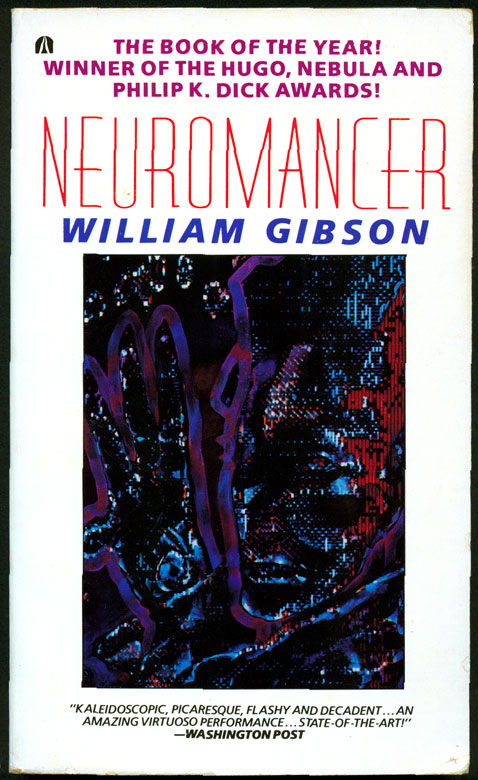
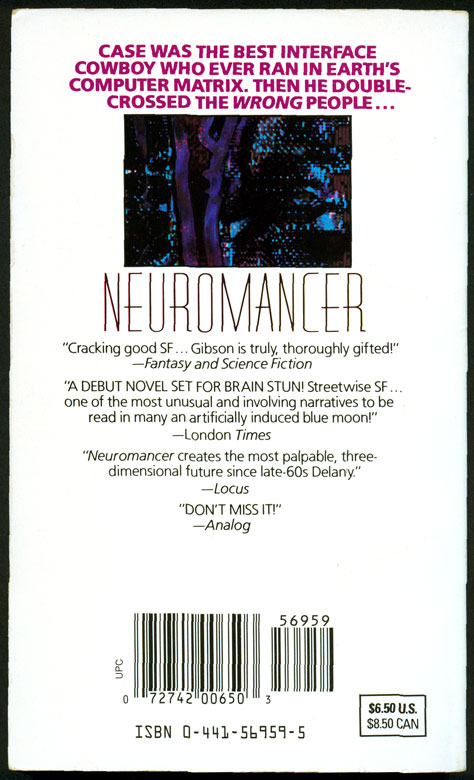
Neuromancer
Cover art: Richard Berry
1988 edition (Ace Books)
Posted: March 29th, 2012 | Author: Max Romero | Filed under: Uncategorized | Tags: Cover to Cover | No Comments »
I’ve always been a fan of tattoo-style art, but I have to admit the artwork for this edition of From Russia With Love tweaks a very specific kind of nostalgia for me — it totally reminds me of the kind of stuff I would see my cholo buddies sketching on their notebooks in high school.
This isn’t to disparage Chris Garver, the tattoo artist who drew the images for this cover as part of the Penguin Ink Series celebrating the publisher’s 75th anniversary. I don’t think I would necessarily want this punched into my skin for the rest of my life, but it’s also a pretty striking design that gives ol’ James Bond a sharper, more modern edge. Until Daniel Craig took over in the film role, the character was getting a little stuffy and dated; I can’t help thinking Penguin was taking a shot at what the movies were doing, bringing James Bond into the grittier and less genteel world we live in (on the surface, at least).
This edition went to press just a couple of years ago, and I’m happy to see it as a possible trend of “alternative” artists being tapped for more mainstream design. (I hope it’s a trend — Penguin also printed The Portable Dorothy Parker with a great cover by Seth, and I know I’ve seen others, though I can’t remember what the hell they were.) And while most of the people who provided work for the series are tattoo artists, I was glad to see someone snuck in poster and comic artist Tara McPherson in there, too.
But like I said, I could look at good tattoo work all day long. And now that I think about it, that back cover would make a nice one … hmmm …
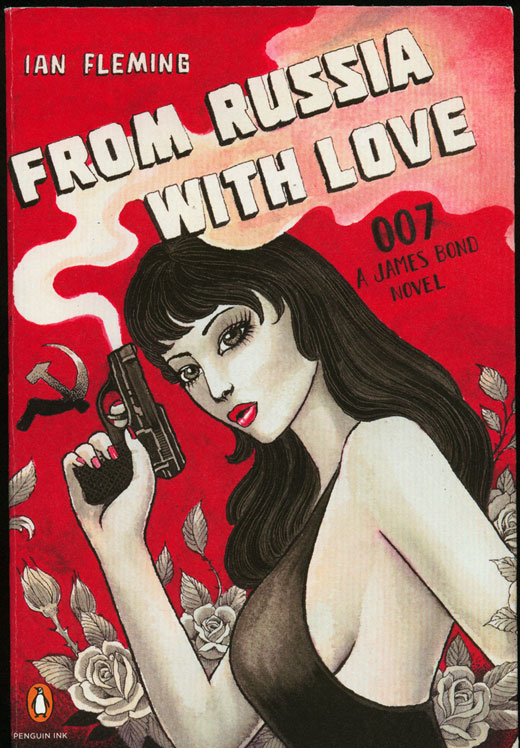

From Russia With Love
Cover art: Chris Garver
2010 edition (Penguin Books)
Posted: February 16th, 2012 | Author: Max Romero | Filed under: Uncategorized | Tags: Cover to Cover | 3 Comments »
Early on, I found myself addicted to science fiction, crime and other types of pulp genres in much the same way most people get hooked on their drug of choice — I was given free tastes in small, easy to swallow doses. In my case, I’ve been mainlining digests and anthologies since elementary school.
Spending time in my aunt’s bookstore meant hours of going through old copies of Analog and Asimov’s Science Fiction. After watching Psycho for the first time, I became hooked on Alfred Hitchcock’s Mystery Magazine, and that eventually led to Ellery Queen’s Mystery Magazine (more imagination went into the stories than the name on the covers, I guess). My aunt, gruff but generous, always sent me home with at least a couple of digests to pore through, and they introduced me to more writers and concepts than I can begin to pin down.
Years later, I found myself in junior high and hating almost everything about it. The school was different (not its fault), the teachers sucked (totally their fault), and isolation was at an all-time high (totally my fault). But the library was like this little, ignored jewel in the middle of a crappy crap-pile, and I’d find the most amazing stuff there. I remember one book about a kid who gets lost in some snowy woods and sees a vision of Socrates, and decides he’ll never lie again; the rest of the novel is about the fallout of his choice. There was another book that told the story of a young girl going through her sexual awakening, and discovering that she is a lesbian in love with her friend (surprisingly for the time, the falling in love was the dramatic part, not the fact she was gay). Unfortunately, the titles of both of these books are long gone now.
Those books I found by accident — but I gravitated toward the anthologies like the USS Cygnus into a black hole. For some reason the school library had all my favorites in big, hardcover collections and I tore through them. If it would have been possible to OD on Hitchcock and sci-fi, I’d have been found twitching on the floor of that library.
So fast-forward to a few months ago, and my wife and I are in my hometown visiting my family for the holidays. At one point during the trip we were browsing through a little bookstore/gallery in near-by Mesilla when I noticed a small bookshelf full of digests; Analog, Hitchcock’s Mystery Magazine, Fantastic Stories, and some I’d never even heard of like Worlds of If. I asked how much they were per copy and while the seller was coming up with a number my mom, in her usual generous and spontaneous way, made an offer for the whole batch, telling me, “It’s your Christmas present.” Mom has always encouraged my habit.
Which is how I came to have a large box of sci-fi paperback novels, best-of anthologies and digests in my closet, including this issue of Analog. One of the things I always enjoy about these digests is trying to figure out what the hell is going on in these images, but this issue has the added pleasure of sporting one of the most bizarre combinations of image and story title I’ve ever seen. ‘Cause, man, that guy is pissed at those kites, and he really wants to know what happened to his purse.
(And just for the record, I … er … might’ve joined one or two sci-fi book clubs, too.)
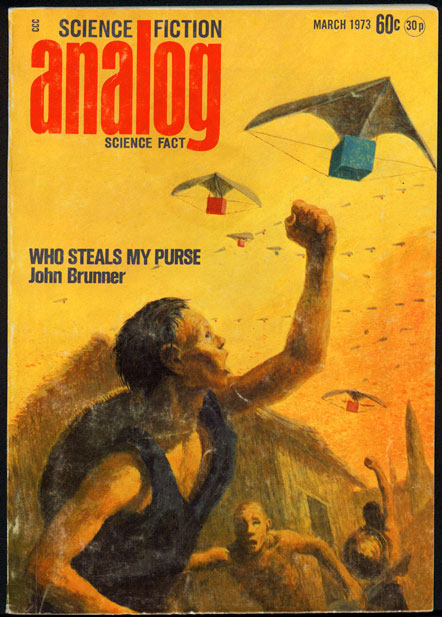
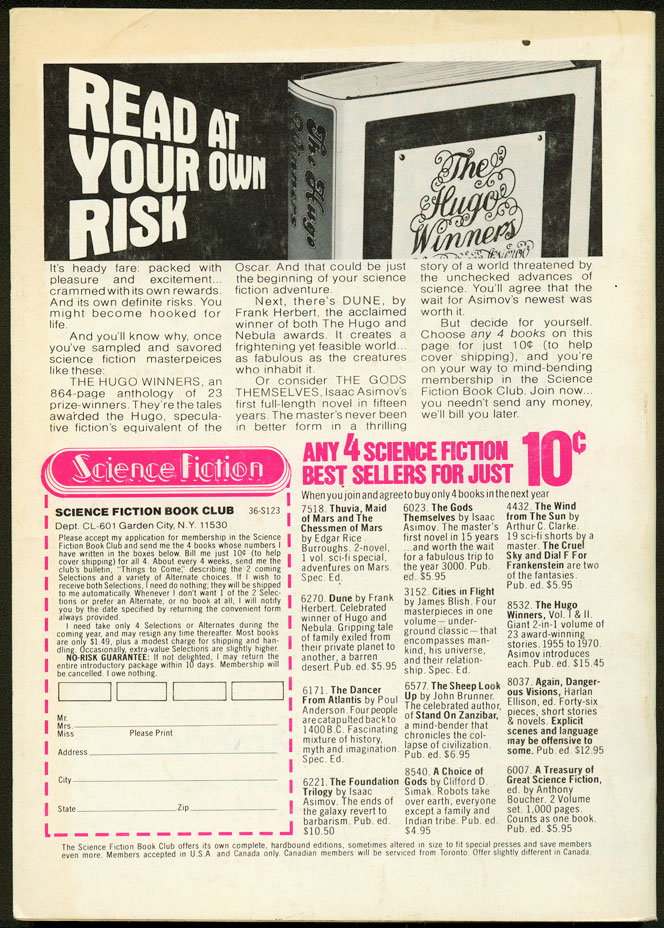
Â
Analog: Science Fiction/Science Fact
Cover by John Schoenherr
March 1973 issue
Posted: January 25th, 2012 | Author: Max Romero | Filed under: Uncategorized | Tags: Cover to Cover, paperbacks | 2 Comments »
Sometimes I buy books I don’t plan on reading.
It doesn’t happen very often — honest — but I’ve done it a couple of times. Sometimes it’s been because a book is just so unusual that I can’t resist it. Sometimes I’ll pick up a book because I think the design is beautiful, and I appreciate it more as an object than prose.
And in the case of Bruce Lee’s Fighting Method: Advanced Techniques, it’s because it’s just so damn cool.
The book is the fourth and final installment in the Fighting Method series, and is crammed full of step-by-step lessons in Lee’s Jeet Kune Do style of martial arts, as well as pictures of Lee beating the hell out of co-author Mitoshi Uyehara. I’m sure the photos are posed, but as we all know Lee could kill 10 normal men even when he was faking it.
For the most part, Advanced Techniques is a fairly dry collection of fighting methods; “your rear hand should be in the guard position” and “the stop-kick is not necessarily a countering blow,” things like that. Which is why I really doubt I’ll ever read it front to back. On the other hand, it is the kind of book I definitely leaf through for the pictures, the casually inserted philosophy, and the literal poetry (not Lee’s, though, and that’s too bad).
But mostly, it’s just nice to have some distilled, Bruce Lee coolness on the book shelf.
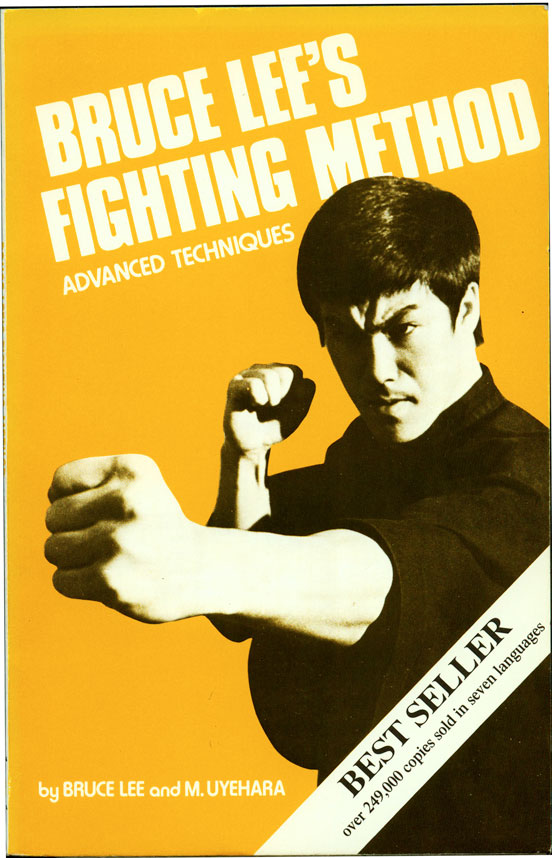
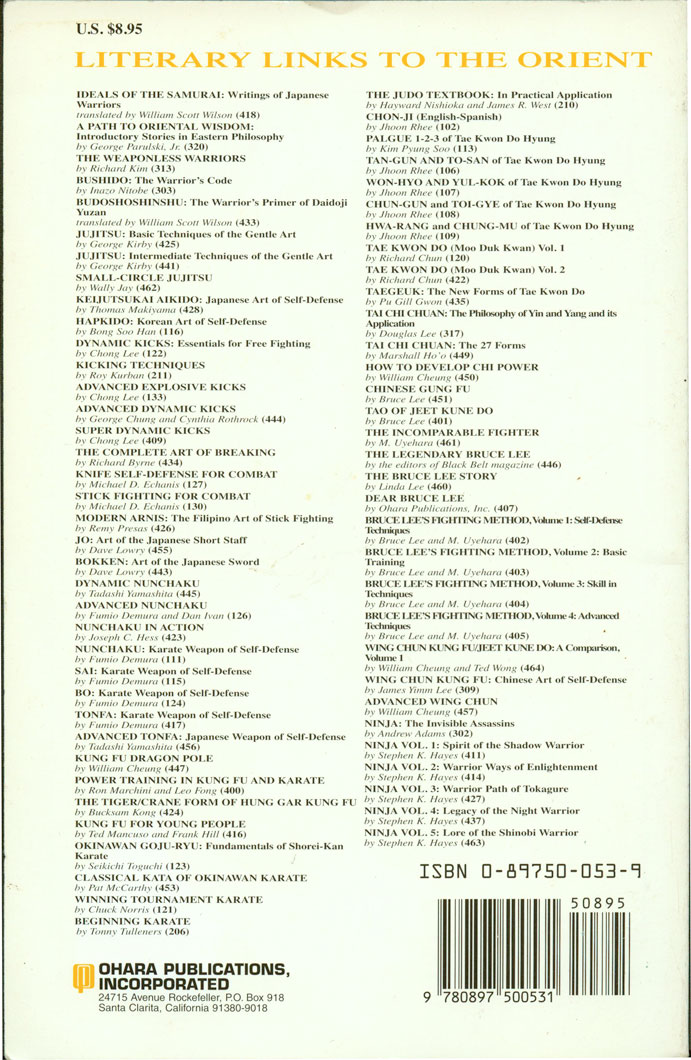
I’ve made the back cover a little bigger (click to see) so it’s easier to go through the list of books Ohara Publications was offering. There are six books on being a ninja, more books by and about Bruce Lee, and even Chuck Norris telling you how to win karate tournaments. If it doesn’t include sweeping the leg, I’m going to be really disappointed.
Bruce Lee’s Fighting Method: Advanced Techniques
Cover design/photo: Unknown
1996 edition (Ohara Publications, Inc.)
Posted: January 11th, 2012 | Author: Max Romero | Filed under: Uncategorized | Tags: Cover to Cover, paperbacks | 2 Comments »
A lot of people have to deal with addiction in their lives. Some are a prisoner to alcohol, to drugs or to some other, just as destructive compulsion. I’m not any different, and have suffered from a nearly uncontrollable urge — a need — that I’ve never really been able to resist. I am weak, and for almost my entire life I’ve thrown time, money and sometimes my personal well-being into this monster’s bottomless maw.
Of course, I’m talking about used paperbacks.
And my addiction has a certain flavor; the more genre-ey, the better. Especially if it has a ridiculously awesome cover. Oh, man, the covers! Horror and science-fiction books have the best, hands downs, and I will gladly leave a used books store with an armful of paperbacks chosen just because the covers gave me a hit of giddy euphoria. Aaahhh — that’s the good stuff.
With that in mind, I thought I’d share some of the most beautiful, most creative or just plain nuttiest covers in my stacks in what will be a new, ongoing feature. And just to be sure you get the full dose of art and promo copy (an art in itself), we’ll be taking a look at both the front and back covers.
First up: Starman Jones!
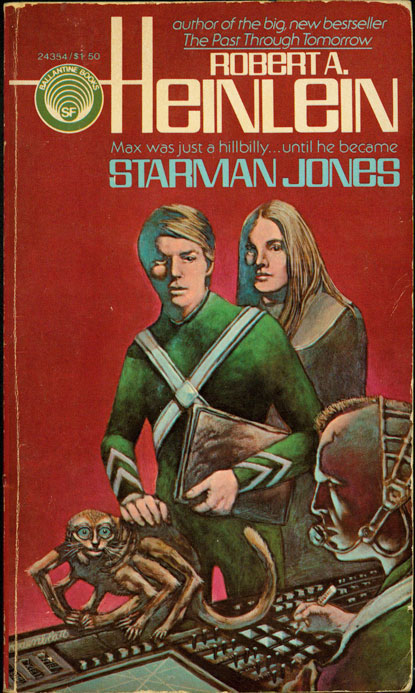
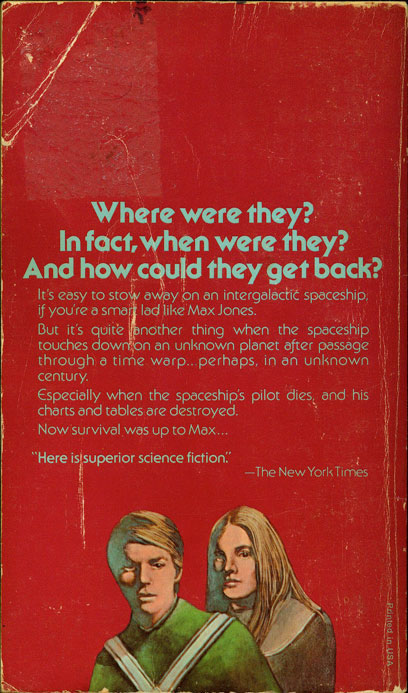 Â
Starman Jones
Cover art: Lee Rosenblatt
1975 edition (Ballantine Books)
Â
Starman Jones
Cover art: Lee Rosenblatt
1975 edition (Ballantine Books)















